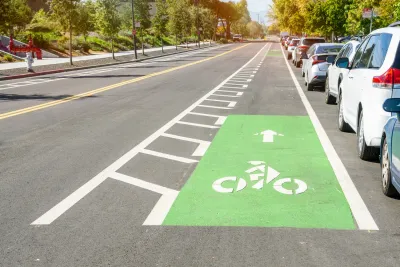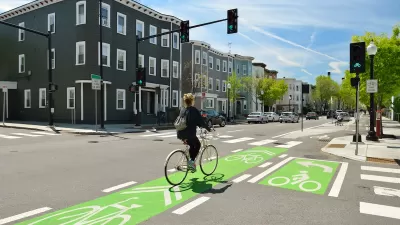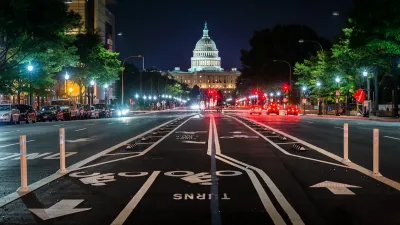Sean Duffy says there’s no evidence that bike lanes have benefits. Streetsblog — and federal agencies’ own data — beg to differ.

U.S. Transportation Secretary Sean Duffy seems to have some inaccurate ideas about bike lanes — so Streetsblog USA created an explainer that outlines the hard data, much of it from the federal government’s own agencies.
The Federal Highway Administration's own website on bike lanes says that even just adding flexible plastic posts to paint-only on-road cycle paths can reduce total crashes up to 53 percent — and of course, putting harder infrastructure like concrete jersey barriers or curbs between cars and fragile human bodies is so much better that most researchers don't even bother to study it.
Data also shows that a sufficiently robust and safe bike lane network does encourage more people to ditch cars and use bikes instead. According to the article, “study after study shows that bike lanes do not make car congestion worse— and in some cases, especially in urban areas that place them strategically, they can actually make it better.”
Disputing Duffy's claim that bike funding takes away from other transportation projects, Streetsblog highlights how little funding actually goes toward bike lanes: “Per the League of American Bicyclists, less than 2 percent of federal transportation funding is spent on biking and walking combined, amounting to $2.36 per person per year.” We hope Secretary Duffy takes Streetsblog’s advice and takes a harder look at his own agencies’ numbers.
FULL STORY: USDOT Secretary Sean Duffy Is Dead Wrong About Bike Lanes

Trump Administration Could Effectively End Housing Voucher Program
Federal officials are eyeing major cuts to the Section 8 program that helps millions of low-income households pay rent.

Planetizen Federal Action Tracker
A weekly monitor of how Trump’s orders and actions are impacting planners and planning in America.

Ken Jennings Launches Transit Web Series
The Jeopardy champ wants you to ride public transit.

Rebuilding Smarter: How LA County Is Guiding Fire-Ravaged Communities Toward Resilience
Los Angeles County is leading a coordinated effort to help fire-impacted communities rebuild with resilience by providing recovery resources, promoting fire-wise design, and aligning reconstruction with broader sustainability and climate goals.

When Borders Blur: Regional Collaboration in Action
As regional challenges outgrow city boundaries, “When Borders Blur” explores how cross-jurisdictional collaboration can drive smarter, more resilient urban planning, sharing real-world lessons from thriving partnerships across North America.

Philadelphia Is Expanding its Network of Roundabouts
Roundabouts are widely shown to decrease traffic speed, reduce congestion, and improve efficiency.
Urban Design for Planners 1: Software Tools
This six-course series explores essential urban design concepts using open source software and equips planners with the tools they need to participate fully in the urban design process.
Planning for Universal Design
Learn the tools for implementing Universal Design in planning regulations.
Ada County Highway District
Clanton & Associates, Inc.
Jessamine County Fiscal Court
Institute for Housing and Urban Development Studies (IHS)
City of Grandview
Harvard GSD Executive Education
Toledo-Lucas County Plan Commissions
Salt Lake City
NYU Wagner Graduate School of Public Service





























